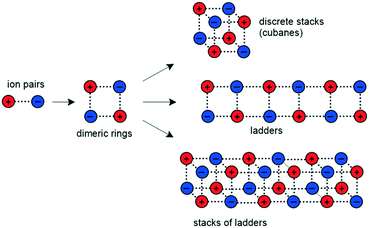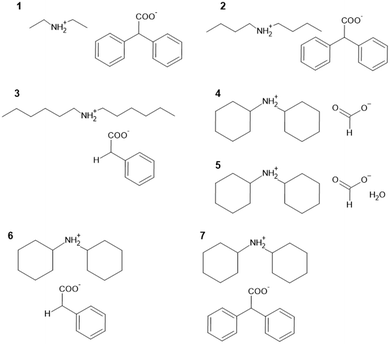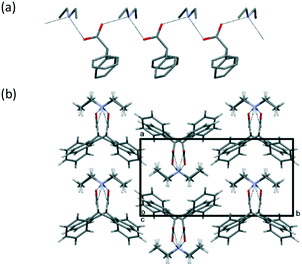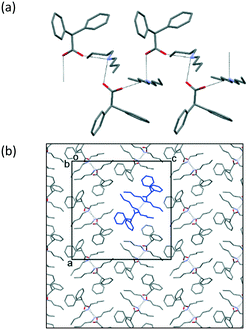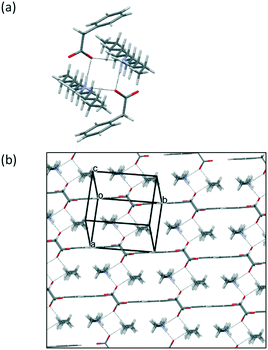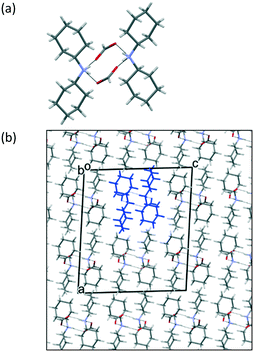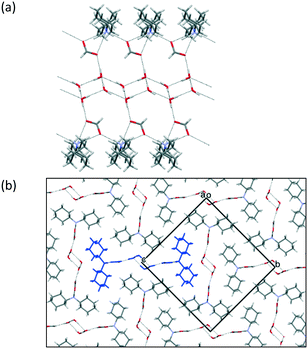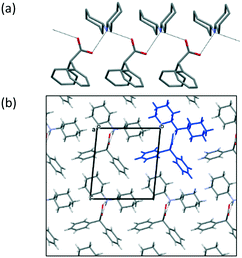Ring stacking and laddering in ammonium carboxylate salts: extension to secondary ammonium salts†
James A.
Odendal
 ,
Jocelyn C.
Bruce
,
Klaus R.
Koch‡
,
Jocelyn C.
Bruce
,
Klaus R.
Koch‡
 and
Delia A.
Haynes
and
Delia A.
Haynes
 *
*
Department of Chemistry & Polymer Science, Stellenbosch University, P. Bag X1, Matieland, 7602, Stellenbosch, South Africa. E-mail: dhaynes@sun.ac.za
First published on 3rd July 2020
Abstract
An analysis of the crystal structures of secondary ammonium carboxylate salts using the ring stacking and laddering principle has been carried out. A Cambridge Structural Database analysis showed that this ionic model is applicable to the structures of these salts, and gives additional insight into their structural motifs. The crystal structures of seven new secondary ammonium carboxylate salts are reported, and analysed in terms of ring stacking and laddering.
Introduction
It is well known that electrostatic interactions in the crystal structures of organic solids are significant, and that these interactions act over long distances (E ∝ q1q2/r), such that electrostatic interactions may be important in drawing molecules together over longer distances during the crystallization process. Due to the importance of electrostatic interactions in molecular crystals, several groups, including our own, have used molecular electrostatic potential maps as a way of rationalising the crystal structures of molecular materials, and of predicting, for example, the likelihood of co-crystal formation.1–7The principles of ring-stacking and ring-laddering were developed by Snaith and co-workers in the 1980s to rationalise the crystal structures of main group amides and imides.8–10 The ring-stacking and laddering concept assumes that cations and anions will maximise their coordination numbers, and thus electrostatic interactions, in the solid state: discrete cation–anion pairs will associate to form dimeric or trimeric rings, which then further associate where possible, to give ladders or stacks (Scheme 1).
In the early 2000s, Bond extended these concepts to the organic solid state, by demonstrating the applicability of the ring stacking and laddering concepts to the structures of organic ammonium halides.11–13 We later showed that the ring stacking and laddering ideas are also useful in rationalising and predicting general packing motifs in ammonium (NH4+) and primary ammonium (R–NH3+) carboxylate salts.14 We showed that the formation of 2-D nets, ladders or cubanes in these salts is affected by the sterics of the substituents on the ions, and these ideas were used to successfully predict the motif (nets, ladders, stacks) in six new 1![[thin space (1/6-em)]](https://www.rsc.org/images/entities/char_2009.gif) :
:![[thin space (1/6-em)]](https://www.rsc.org/images/entities/char_2009.gif) 1 ammonium carboxylate salts. In the current manuscript, we extend this analysis to secondary ammonium (R2–NH2+) carboxylate salts. A detailed Cambridge Structural Database (CSD)15 analysis is described, and the crystal structures of seven new salts are reported. A summary of the applicability of the stacking and laddering principle to all ammonium carboxylate salts is presented.
1 ammonium carboxylate salts. In the current manuscript, we extend this analysis to secondary ammonium (R2–NH2+) carboxylate salts. A detailed Cambridge Structural Database (CSD)15 analysis is described, and the crystal structures of seven new salts are reported. A summary of the applicability of the stacking and laddering principle to all ammonium carboxylate salts is presented.
Results
CSD search details, as well as experimental procedures, are given in the experimental section of the manuscript.CSD analysis
The best R-factor list in CSD was searched for salts containing C–N+H2–C and COO−. In order to allow comparison to our previous study,14 we restricted the study of motifs in secondary ammonium carboxylate salts to monoammonium monocarboxylate salts with no competing hydrogen bonding functionality. Solvates, co-crystals and zwitterions were also excluded. This gave a list of 130 structures of simple secondary ammonium carboxylate salts (refcode lists are provided in the ESI†).Analysis of the structures in terms of stacking and laddering was carried out in the first instance by searching for close contacts between the ammonium N atom and the C atom of the carboxylate, at a distance of the sum of the van der Waals radii + 1.1 Å. This distance cut-off is consistent with our previous work, where it was chosen based on measurements made on hydrogen-bonded ammonium and carboxylate ions.14 These searches, along with manual inspection of the structures, revealed that 9 of the structures contain ladder motifs (7%), 66 contain one-dimensional chains (1D, 51%) and 55 contain discrete ring motifs (0D, 42%).
Similar searches for tertiary ammonium carboxylate salts yielded only 16 structures, all of which contain discrete single contacts between the cation and the anion. These will not be considered further.
Crystal structures of new salts
The crystal structures of six new salts, and one salt hydrate, were determined (Scheme 2). Selected hydrogen bond parameters and crystallographic details are tabulated in the ESI.†![[1 with combining macron]](https://www.rsc.org/images/entities/char_0031_0304.gif) , with one cation and one anion in the asymmetric unit. Two cations and two anions form a discrete hydrogen-bonded ring (graph set R2,4(8), Fig. 3a). These rings pack alongside one another, with alkyl chains parallel, to form layers (Fig. 3b). Similar alkyl–alkyl interactions have been observed in related salts.16 Layers pack on top of one another in an offset fashion.
, with one cation and one anion in the asymmetric unit. Two cations and two anions form a discrete hydrogen-bonded ring (graph set R2,4(8), Fig. 3a). These rings pack alongside one another, with alkyl chains parallel, to form layers (Fig. 3b). Similar alkyl–alkyl interactions have been observed in related salts.16 Layers pack on top of one another in an offset fashion.
![[1 with combining macron]](https://www.rsc.org/images/entities/char_0031_0304.gif) with a cation–anion pair in the asymmetric unit. Cation and anions hydrogen bond to form a chain parallel to the a-axis, similar to those seen in 5 and 7 (Fig. 6a, cf.Fig. 5a and 7a). Chains pack together, related by inversion, to give the complete structure (Fig. 6b).
with a cation–anion pair in the asymmetric unit. Cation and anions hydrogen bond to form a chain parallel to the a-axis, similar to those seen in 5 and 7 (Fig. 6a, cf.Fig. 5a and 7a). Chains pack together, related by inversion, to give the complete structure (Fig. 6b).
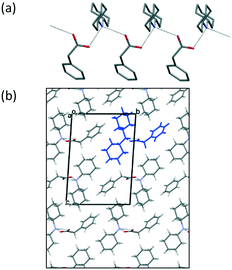 | ||
| Fig. 6 (a) Hydrogen-bonded chains in 6. Hydrogen atoms have been omitted for clarity. (b) Packing in 6 viewed along the a-axis. One hydrogen-bonded chain is highlighted in blue. | ||
Discussion
Our previous work showed that the ring stacking and laddering concepts, which are based on the tendency of ions to arrange in the solid state so as to maximise electrostatic interactions, are applicable to ammonium and primary ammonium carboxylate salts.14 Here, we have extended our analysis to secondary ammonium carboxylate salts.We identified a set of 130 simple secondary ammonium monocarboxylate salts in the CSD (solvates and zwitterions were removed, see experimental for details). Unsurprisingly, in all of these salts, at least one hydrogen bond forms between the NH2+ and the COO−.
We have analysed these 130 structures for occurrence of ring stacking and laddering. Due to the difficulty in pinpointing the centre of the charge on the carboxylate ion, it is not straightforward to measure close contacts to this ion in a meaningful way, which has limited to some extent how our analysis could be carried out. Instead of assessing ‘next longest distance’ as per Bond's analyses of ammonium halides,11 we have chosen to search for motifs with contacts to the anion defined as contacts to the carbon atom of the carboxylate, as per our previous manuscript.14 Analysis of the structures shows that 42% form a discrete 0D ring of cations and anions (Fig. 8a), 7% form ladders (Fig. 8b) and the remaining 51% have a 1D cation–anion chain (Fig. 8c).
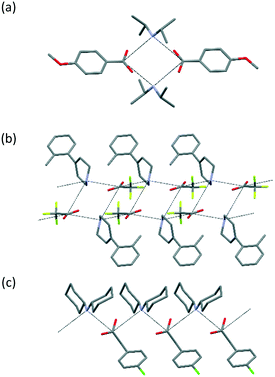 | ||
| Fig. 8 Cation–anion motifs in secondary ammonium carboxylate salts. (a) Discrete 0D motif in EVIHOH.17 (b) Ladder in EQEWII.18 (c) 1D chain in CENXAX.19 Hydrogen atoms have been removed for clarity. Dotted lines indicate contacts between the cation and the anion, as defined in the text. | ||
The ladders in the 9 structures that show them all have a zig-zag topology, and can be viewed as constructed from associations of hydrogen-bonded chains of ions (Fig. 9a). These are analogous to the type 1 ladder described by Bond,11 where the contact making up the rung of the ladder is a longer contact. These can also be described as slipped stacks of 0D rings.
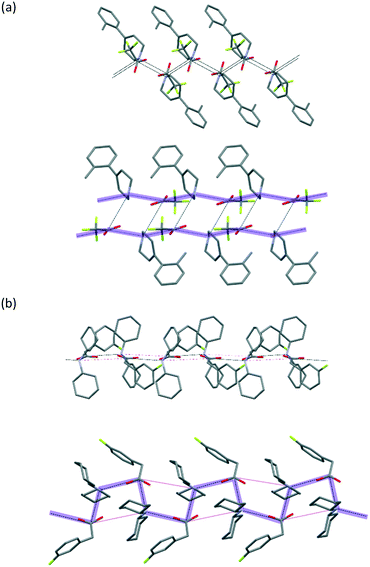 | ||
| Fig. 9 (a) Type 118 and (b) type 219 ladders from the side (top), and highlighting hydrogen bonds in purple (bottom). Long contacts in (b) are in pink. Hydrogen atoms have been omitted for clarity. | ||
Several of the structures containing one-dimensional chains can in fact be described as ladders with one long contact along the ladder sides (longer than the defined sum of the van der Waals radii + 1.1 Å). There are 25 such structures, which are analogous to the type 2 ladders described by Bond,11 where the shortest cation–anion contacts, along the direction of the hydrogen bonds, form a trans,trans chain of ions. However, each cation also has a further longer contact at the ‘back’ of the cation, i.e. along the general direction of one of the N–H bonds (Fig. 9b). This longer contact completes the ladder. This occurs despite the apparent steric hindrance at the back of the cation. Electrostatic potential maps have been calculated for a small selection of cations (ESI† Fig. S2), confirming that the positive potential extends around the ion – a contact between the ‘back’ of the cation and the anion will still be electrostatically favourable. Including these 25 ladders changes the percentage of structures that form ladders to 26%, with one-dimensional chains dropping to 32%.
The list of 130 simple secondary ammonium carboxylate salts contains several series of salts with a common cation. Many of these structures were determined by Dastidar and co-workers as part of their studies on structure–property correlations in low molecular weight gelators. Particularly interesting are the series of dicyclohexylammonium salts,16,19–21 46 of which are included in our set of 130 structures. This set of structures was particularly helpful in an assessment of the relationship between substituent and motif.
As Roy et al. note in their 2018 paper, ‘it is difficult to rationalise the outcome of the SAM synthon (0D or 1D) based on the molecular structure of the corresponding salt’ (SAM is secondary ammonium monocarboxylate).19 However, some insight can be gained using the stacking and laddering ideas developed by Downard and Chivers.22 Motifs are built up from a cation–anion pair, which then further associates to maximise electrostatic interactions and close packing, whilst minimising steric clashes. Discrete 0D rings will maximise electrostatics, so are favoured. If these can further associate (also favoured), type 1 ladders form (see above). This will depend on the steric bulk and conformational flexibility of the substituents on both the cation and the anion. Type 2 ladders, on the other hand, are favoured when a 0D motif would result in an awkward shape. Association of cation–anion units to form 1D chains appears to be determined by the shape of the resulting construct, which is affected by both steric interactions between substituents (flat anions are more likely to align alongside one another), and differences in size between the cation and the anion. Put another way, if a cation–anion chain allows substituents to pack effectively when arranged in an alternation fashion on opposite sides of the chain, a type 2 ladder will form. If the substituents pack more effectively when arranged on the same side of the cation–anion chain (see Fig. 8c), either a ladder or a 1D motif will result, depending on whether the chains so formed can further associate. The motif formed after cation–anion association has occurred is thus largely driven by steric effects in this sample.
We can use these ideas to rationalise the ring stacking and laddering motifs that form in some of the new crystal structures we report here, based on the shape and steric demand of the substituents. In dicyclohexylammonium formate (4) a type 2 ladder is expected based on the discussion above. In dicyclohexylammonium phenylacetate (6) a 1D chain is anticipated, whilst dicyclohexylammonium diphenylacetate (7) is expected to show a 0D motif. In 4, a ladder can be identified, but it is made up of discrete hydrogen-bonded units with long contacts between them. Salts 6 and 7 both have 1D chains. This was unexpected in 7, and possibly arises due to the complementary shapes of the cation and the anion.
It is more difficult to rationalise the motifs seen in the other three salts. The contrast between 1 (diethylammonium diphenylacetate) and 2 (dibutylammonium diphenylacetate) is interesting. Salt 1 has a 1D chain, whilst 2 has a type 2 ladder. Again the 1D chain appears to be favoured by the complementary fit of the cation and anion, whilst the type 2 ladder is stabilised by association of the longer alkyl groups on the cation in 2. Salt 3 shows a discrete 0D motif, again stabilised by alkyl–alkyl interactions. It is clear that the nature of the substituent is critical in determining the resulting motif, but prediction of the motif expected to form is more difficult than with the primary ammonium carboxylate salts.14 This is perhaps not unexpected, considering the larger number of substituents involved in secondary ammonium salts: steric effects, which are harder to predict, are more important in this series, and sometimes dominate over electrostatic effects.
The set of 46 dicyclohexylammonium salts discussed above also provide some insight into what can be gained from an analysis of packing in terms of ring stacking and laddering in addition to hydrogen bonding. Dastidar and co-workers16,19–21 note that all salts containing a 0D hydrogen bonding motif in their crystal structures are not gelators. They also observe that gelators contain hydrogen-bonded chains. However, in their 2018 paper, they report a number of dicyclohexylammonium salts with hydrogen-bonded chains are not gelators, leading the authors to conclude that hydrogen bonded chains are a necessary but not sufficient condition for gelation.19 We have analysed the series of dicyclohexylammonium salts in terms of ring stacking and laddering, and find that almost without exception the materials that do not gelate contain either 0D motifs or type 2 ladders (which contain a hydrogen-bonded chain). The salts that are gelators all contain a 1D cation–anion motif. Of the 42 salts we assessed, only three do not follow this trend: CENYIG, JEFZEA and JEFZIE. These three salts contain 1D motifs in their crystal structures, but are not gelators. It is interesting to note that in the series of dibenzylamine salts reported by this same group, a similar relationship does not hold. In this series there are many salts with type 2 ladders in their crystal structures that are in fact gelators. Nonetheless, these systems highlight the insight that can be gained from an analysis of structures in terms of electrostatic interactions.
Summary of ring stacking and laddering in ammonium carboxylate salts
Table 1 provides a summary of the ring stacking and laddering motifs observed across all the salts investigated in our work to date. It is clear that stacking and laddering motifs do occur in these salts, and that the dimensionality of the motif decreases with increasing substitution of the cation. Stacks, nets, ladders and cubanes are all observed. In ammonium carboxylate salts, the cation is small, and electrostatic factors dominate in the crystal structures. Nets are frequently observed, and the formation of stacks and ladders is dependent on the anion size and functionality. In primary ammonium carboxylate salts, there is a balance between steric and electrostatic factors. In these salts, the formation of nets or ladders is quite clearly related to the cross-sectional area of the cation when viewing down the C–NH3+ bond: larger cations give ladders.14 The large cations in secondary ammonium carboxylate salts mean that steric factors become more important. Fewer extended motifs are observed, and prediction of motif becomes more difficult.| Motif | Ammonium (NH4+) carboxylate salts14 (10 structures) | Primary ammonium (C–NH3+) carboxylate salts14 (147 structures) | Secondary ammonium (C–NH2+–C) carboxylate salts (130 structures) |
|---|---|---|---|
| Nets | 40% 3D nets of nets |
23% |
NONE |
| Stacks | 60% stacks of ladders (nets along stack direction)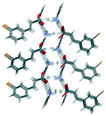 |
3% cubanes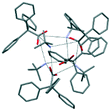 |
NONE |
| Ladders | See above – all are stacks of ladders | 71%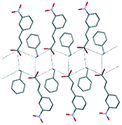 |
26% |
| 0-D | NONE | 3%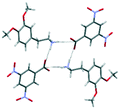 |
42% |
| 1-D | NONE | NONE | 32% |
As Bond11 did, we note that the existence of nets containing 4-membered rings in the primary ammonium carboxylate sample, and ladders in the secondary ammonium carboxylates, illustrates that hydrogen bonds are not the dominant factor (or certainly not the only factor) in the association of cations and anions in these salts.
The formal analogy between ring stacking and laddering in ammonium halides and main group amide/imide complexes has been expanded in detail by Bond.11 Particularly, he notes that primary and secondary ammonium cations can be compared to RN2− and R2N− amide moieties: both tend towards tetrahedral coordination in their ‘coordination sphere’. Halides are comparable to metal cations in terms of their bonding requirements, in that bonding to halides is essentially isotropic. This is not the case for carboxylates, which have clear directional hydrogen-bonding preferences. However, we still see stacking and laddering in these salts. This lends strong support to the idea that hydrogen bonding is not the dominant factor in association of these moieties in the solid state.
Experimental
Cambridge Structural Database analysis
CSD searches were carried out using ConQuest23 version 2.0.4 on version 5.41 of the database (November 2019). Searches were restricted to the ‘best R-factor list’, with the filters ‘3D coordinates determined’ and ‘only organics’.Zwitterions were identified by searching for intramolecular contacts between cationic and anionic moieties separated by 1–999 bonds with a distance of 0–50 Å. Solvates and co-crystals were removed by only allowing structures with number of residues <3. Structures containing other hydrogen bonding functionality (OH, COOH, ![[double bond, length as m-dash]](https://www.rsc.org/images/entities/char_e001.gif) O, NH, other NHx+, aromatic N) and those containing di-ions (or more highly charged ions) were removed manually after inspection.
O, NH, other NHx+, aromatic N) and those containing di-ions (or more highly charged ions) were removed manually after inspection.
Cation–anion close contacts were defined as in our previous work,14 as a close contact between the C of the carboxylate and the N of the ammonium at a distance shorter than the sum of the van der Waals radii + 1.1 Å.
Synthesis
Six amines (diethylamine, dibutylamine, dihexylamine, dioctylamine, diphenylamine and dicyclohexylamine) were screened against eight monocarboxylic acids (formic, acetic, propionic, butanoic, benzoic, phenylacetic, hexahydrobenzoic and diphenylacetic acids). Various acid![[thin space (1/6-em)]](https://www.rsc.org/images/entities/char_2009.gif) :
:![[thin space (1/6-em)]](https://www.rsc.org/images/entities/char_2009.gif) base ratios and various solvents were investigated. In most cases, the products of the reactions were oils. Single crystals were obtained in seven cases; the synthesis of these is described below. Dioctylamine and diphenylamine formed fine powders in combination with all acids, but no crystals suitable for single-crystal X-ray diffraction experiments were obtained.
base ratios and various solvents were investigated. In most cases, the products of the reactions were oils. Single crystals were obtained in seven cases; the synthesis of these is described below. Dioctylamine and diphenylamine formed fine powders in combination with all acids, but no crystals suitable for single-crystal X-ray diffraction experiments were obtained.
![[thin space (1/6-em)]](https://www.rsc.org/images/entities/char_2009.gif) :
:![[thin space (1/6-em)]](https://www.rsc.org/images/entities/char_2009.gif) 1 MeOH
1 MeOH![[thin space (1/6-em)]](https://www.rsc.org/images/entities/char_2009.gif) :
:![[thin space (1/6-em)]](https://www.rsc.org/images/entities/char_2009.gif) H2O then mixed. One week of slow evaporation at room temperature resulted in needle-like colourless crystals.
H2O then mixed. One week of slow evaporation at room temperature resulted in needle-like colourless crystals.
X-ray diffraction
Single crystal X-ray diffraction data were collected on a Bruker-Nonius SMART Apex diffractometer equipped with a fine-focus sealed tube and a 0.5 mm Monocap collimator (monochromated Mo-Kα radiation, λ = 0.71073 Å). Crystals were mounted on MiTeGen mounts in Paratone oil. Data were captured with a CCD (charge-coupled device) area-detector and temperature was controlled using a 700 Series Cryostream Plus produced by Oxford Cryogenics. Data reduction, absorption corrections and unit cell determination were carried out using the diffractometer software (APEXII, Bruker24). Structures were solved and refined using the ShelX25 suite of programs implemented in XSeed.26 Figures were generated using Mercury.27Thermal analysis
TGA was carried out using a TA Instrument Q500 analyser under N2 with a flow rate of 50 ml min−1.Conclusions
An extensive analysis of structural motifs in secondary ammonium carboxylate salts from the perspective of ring stacking and laddering has been carried out. It is shown that ring stacking and laddering concepts can be effectively applied to the structures of these salts: it is clear that maximising electrostatic interactions is significant in their crystal structures. Motif prediction is more challenging for secondary ammonium carboxylate salts than for ammonium or primary ammonium carboxylate salts due to the increased significance of steric factors.When describing the structures of organic salts, the focus in the literature remains on hydrogen bonding patterns. We hope that analysis of organic salts in terms of ring stacking and laddering concepts, i.e. with the focus on electrostatic interactions, may provide a different perspective, and thus further insight, into the factors governing the crystal structures of organic salts.
Conflicts of interest
There are no conflicts to declare.Acknowledgements
We particularly acknowledge the late Professor Klaus Koch, whose influence on all the authors' lives, both professionally and personally, was significant. He provided us with opportunities, and encouraged us to grow as researchers. He is greatly missed. We thank the National Research Foundation and Stellenbosch University for funding. We thank Dr Jan Gertenbach for assistance with X-ray data collection, which was carried out on instruments managed at the time by the Central Analytical Facility of Stellenbosch University. We also thank Prof Catharine Esterhuysen for help with ESP calculations. This material is based upon work supported financially by the National Research Foundation of South Africa.Notes and references
- A. D. Bond, D. A. Haynes, C. M. Pask and J. M. Rawson, J. Chem. Soc., Dalton Trans., 2002, 2522–2531 RSC
.
- C. S. Clarke, D. A. Haynes, J. N. B. Smith, A. Batsanov, J. A. K. Howard, S. I. Pascu and J. M. Rawson, CrystEngComm, 2010, 12, 172–185 RSC
.
- D. A. Haynes and J. M. Rawson, Eur. J. Inorg. Chem., 2018, 31, 3554–3564 CrossRef
.
- M. A. Spackman, J. J. McKinnon and D. Jayatilaka, CrystEngComm, 2008, 10, 377–388 CAS
.
- See for example M. D. Perera, J. Desper and C. B. Aakeröy, CrystEngComm, 2016, 18, 8631–8636 RSC
.
- D. Musumeci, C. A. Hunter, R. Prohens, S. Scuderi and J. F. McCabe, Chem. Sci., 2011, 2, 883–890 RSC
.
- B. Sandhu, A. McLean, A. S. Sinha, J. Desper, A. A. Sarjeant, S. Vyas, S. M. Reutzel-Edens and C. B. Aakeröy, Cryst. Growth Des., 2018, 18, 466–478 CrossRef CAS
.
- D. Barr, W. Clegg, R. E. Mulvey, R. Snaith and K. Wade, J. Chem. Soc., Chem. Commun., 1986, 295–297 RSC
.
- D. R. Armstrong, D. Barr, W. Clegg, R. E. Mulvey, D. Reed, R. Snaith and K. Wade, J. Chem. Soc., Chem. Commun., 1986, 869–870 RSC
.
- R. E. Mulvey, Chem. Soc. Rev., 1998, 27, 339–346 RSC
.
- A. D. Bond, Coord. Chem. Rev., 2005, 249, 2035–2055 CrossRef CAS
.
- A. D. Bond, Cryst. Growth Des., 2005, 5, 755–771 CrossRef CAS
.
- A. D. Bond, Chem. – Eur. J., 2004, 10, 1885–1898 CrossRef CAS PubMed
.
- J. A. Odendal, J. C. Bruce, K. R. Koch and D. A. Haynes, CrystEngComm, 2010, 12, 2398–2408 RSC
.
- C. R. Groom, I. J. Bruno, M. P. Lightfoot and S. C. Ward, Acta Crystallogr., Sect. B: Struct. Sci., Cryst. Eng. Mater., 2016, 72, 171–179 CrossRef CAS PubMed
.
- D. R. Trivedi and P. Dastidar, Cryst. Growth Des., 2006, 6, 1022–1026 CrossRef CAS
.
- B. Wei, Acta Crystallogr., Sect. E: Struct. Rep. Online, 2011, 67, o1865 CrossRef CAS PubMed
.
- R. Davidson, Y.-T. Hsu, T. Batchelor, D. Yufit and A. Beeby, Dalton Trans., 2016, 45, 11496–11507 RSC
.
- R. Roy, T. K. Adalder and P. Dastidar, Chem. – Asian J., 2018, 13, 552–559 CrossRef CAS PubMed
.
- D. R. Trivedi, A. Ballabh, P. Dastidar and B. Ganguly, Chem. – Eur. J., 2004, 10, 5311–5322 CrossRef CAS PubMed
.
- D. R. Trivedi, A. Ballabh and P. Dastidar, J. Mater. Chem., 2005, 15, 2606–2614 RSC
.
- A. Downard and T. Chivers, Eur. J. Inorg. Chem., 2001, 2193–2201 CrossRef
.
- I. J. Bruno, J. C. Cole, P. R. Edgington, M. Kessler, C. F. Macrae, P. McCabe, J. Pearson and R. Taylor, Acta Crystallogr., Sect. B: Struct. Sci., 2002, 58, 389–397 CrossRef PubMed
.
-
Bruker, APEX II, SAINT and SADABS, Bruker AXS Inc., Madison, Wisconsin, USA, 2009 Search PubMed
.
- G. M. Sheldrick, Acta Crystallogr., Sect. A: Found. Crystallogr., 2008, 64, 112–122 CrossRef CAS PubMed
.
- L. J. Barbour, J. Supramol. Chem., 2001, 1, 189–191 CrossRef CAS
.
- C. F. Macrae, I. Sovago, S. J. Cottrell, P. T. A. Galek, P. McCabe, E. Pidcock, M. Platings, G. P. Shields, J. S. Stevens, M. Towler and P. A. Wood, J. Appl. Crystallogr., 2020, 53, 226–235 CrossRef CAS PubMed
.
Footnotes |
| † Electronic supplementary information (ESI) available: Crystal structures in cif format, crystallographic details, hydrogen bond tables, ESP maps, refcode lists. CCDC 1998492–1998498. For ESI and crystallographic data in CIF or other electronic format see DOI: 10.1039/d0ce00616e |
| ‡ Deceased 2 January 2020. |
| This journal is © The Royal Society of Chemistry 2020 |

